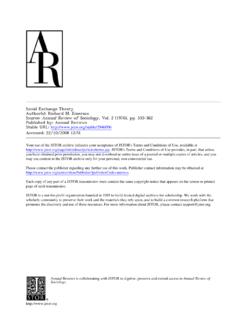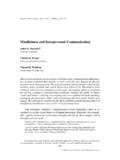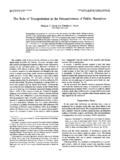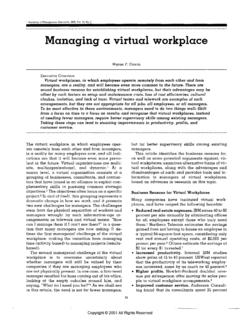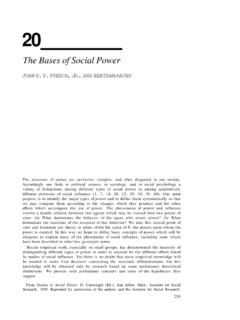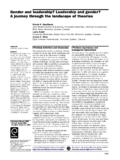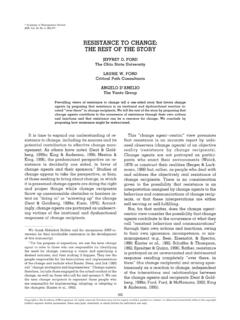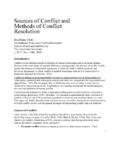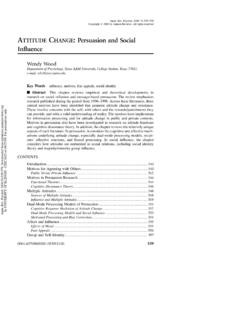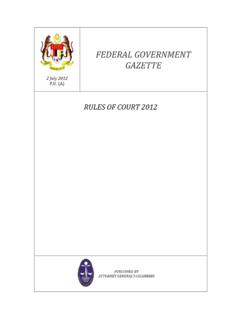Transcription of Developmental Sequence in Small Groups'
1 Classics for Group FacilitatorsDevelopmental Sequence in Small Groups' Bruce W. Tuckman Editor's Note As group facilitators we are often concerned about the development of the groups with which we work. Frequently we make reference to "the stages of group development" and the stages most frequently cited are forming, storming, norming and performing. These stages were proposed by Bruce Tuckman in 1965 based on his examination of empirical research studies. In this classic article, Developmental Sequence in Small Groups, we find a rich description of these stages under a variety of settings as well as their applicability to both group structure and task activity.
2 Table 1: Stages of Group DevelopmentGroup Structure The pattern of interpersonal relationships; the way members act and relate to one another. Forming: orientation, testing and dependence Storming: resistance to group influence and task requirements Norming: openness to other group members Testing and dependence Intragroup conflict In a subsequent 1977 article, Stages of Small -Group Development Revisited, Tuckman and coauthor Mary Ann Jensen noted that subsequent empirical studies suggested a termination stage which they named adjourning. While Table 1 below summarizes the stages with a description of their associated group structures and task activities, the original article provides a much more complete understanding of their context, meaning, and limitations.
3 Although other articles in this special issue suggest the limitations of "stage models" such as this, the memorability and popularity of Tuckman's model make this article required reading for every group facilitator. - Sandor P. Schuman, Editor Task Activity The content of interaction as related to the task at hand. Orientation to the task Emotional response to task demands Open exchange of relevant interpretations; intimate, personal opinions are expressed Interpersonal structure becomes the tool of task activities; group energy is channeled into the task; solutions can emerge Ingroup feeling and cohesiveness develop; new standards evolve and new roles are adopted Roles become flexible and functional; structural issues have been resolved; structure can support task performance Anxiety about separation and termination; sadness.
4 Feelings toward leader and group members Performing: constructive action Adjourning: disengagement Self-evaluation Copyright 1965 by the American Psychological Association. Reprinted with permission. This article appeared in Psychological Bulletin, Volume 63, Number 6, Pages 384-99. 66 Special Issue on Group Development Author's Note My first professional job was as part of a Small group of social psychologists in a think tank setting studying Small group behavior as the US Navy prepared for a future of Small crew vessels and stations. Nine of us at the Naval Medical Research Institute were busy studying Small groups from all perspectives and under all conditions.
5 I was fortunate to have an experienced and talented boss by the name of Irwin Altman, who had been collecting every article he could find on group development. He turned his collection over to me and suggested that I look it over and see if I could make anything out of it. The collection contained 50 articles, many of which were psychoanalytic studies of therapy or Tgroups. The task of organizing and integrating them was challenging. After separating out two realms of group functioning, namely, the interpersonal or group structure realm and the task activity realm, I began to look for a Developmental Sequence that would fit the findings of a majority of the studies.
6 I hit on four stages going from (1) orientation/testing/dependence, to (2) conflict, to (3) group cohesion, to (4) functional role-relatedness. For these I coined the terms: forming, storming, norming, and performing-terms that would come to be used to describe developing groups for the next 20 years and which probably account for the paper's popularity. There still remained the task of getting the paper published and that was no mean feat. Lloyd Humphreys, then editor of the Psychological Bulletin, turned it down, offering me constructive editorial criticism, but concluding that the reviewed studies themselves were not of sufficient quality to merit publication.
7 I was persistent, though, and rewrote the manuscript per his recommendations and sent it back to him, despite his initial outright rejection. I pointed out that I was not trying to justify the collected articles but to draw inferences from them. Humphreys did a complete about-face and accepted my argument and my manuscript and, in short order, it appeared in print. I ordered, thanks to the navy, 450 reprints and used them all to fill requests within the first three or four years after the article appeared. Requests came from all over the world and from a wide range of disciplines and I have saved some of the more exotic ones.
8 Almost yearly, I receive a request from someone to use parts of the article or at least the terms forming, storming, norming, and performing in print. Again, quotability may be the key to success. In 1977, I published, by invitation, an update of the model in a journal called Group & Organization Studies-in collaboration with Mary Ann Jensen.' We reviewed 22 studies that had appeared since the original publication of the model and which we located by means of the Social Sciences Citation Index. These articles, one of which dubbed the stages hickman's hypothesis,2 tended to support the existence of the four stages, but also suggested a fifth stage for which a perfect rhyme could not be found.
9 We called it `adjourning.' Abstract Fifty articles dealing with stages of group development over time are separated by group setting, as follows: therapy-group studies, T-group studies, and natural- and laboratory-group studies. The stages identified in these articles are separated into those descriptive of social or interpersonal group activities and those descriptive of group-task activities. Finally, 4 general stages of development are proposed, and the review consists of fitting the-stages identified in the literature to those proposed.
10 In the social realm, these stages in the Developmental Sequence are testing-dependence, conflict, cohesion, and functional roles. In the task realm, they are orientation, emotionality, relevant opinion exchange, and the emergence of solutions. There is a good fit between observed stages and the proposed model. Further study of temporal change as a dependent variable via the manipulation of specific independent variables is suggested. The purpose of this article is to review the literature dealing with the Developmental Sequence in Small groups, to evaluate this literature as a body, to extrapolate general concepts about group development and to suggest fruitful areas for further research.
